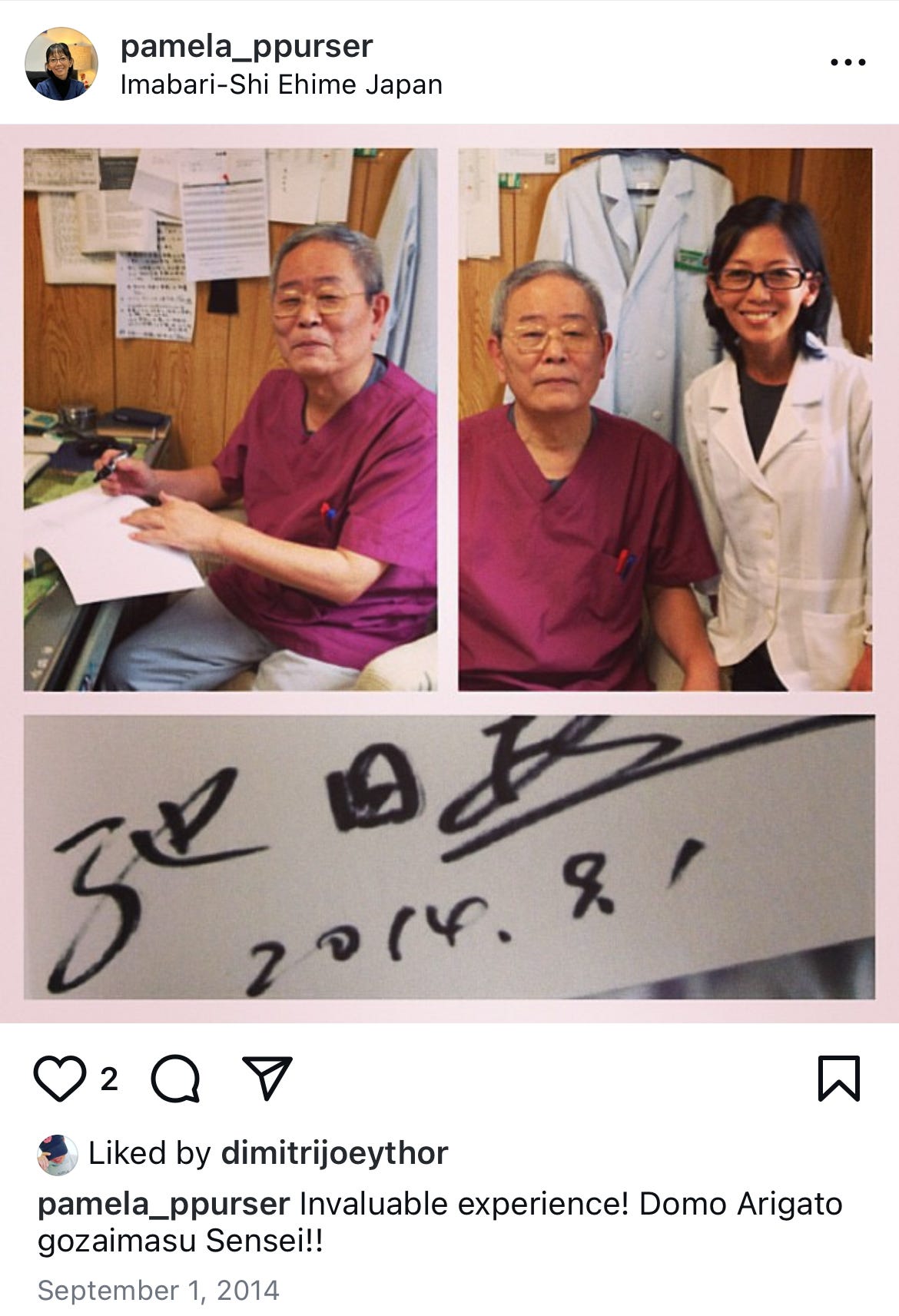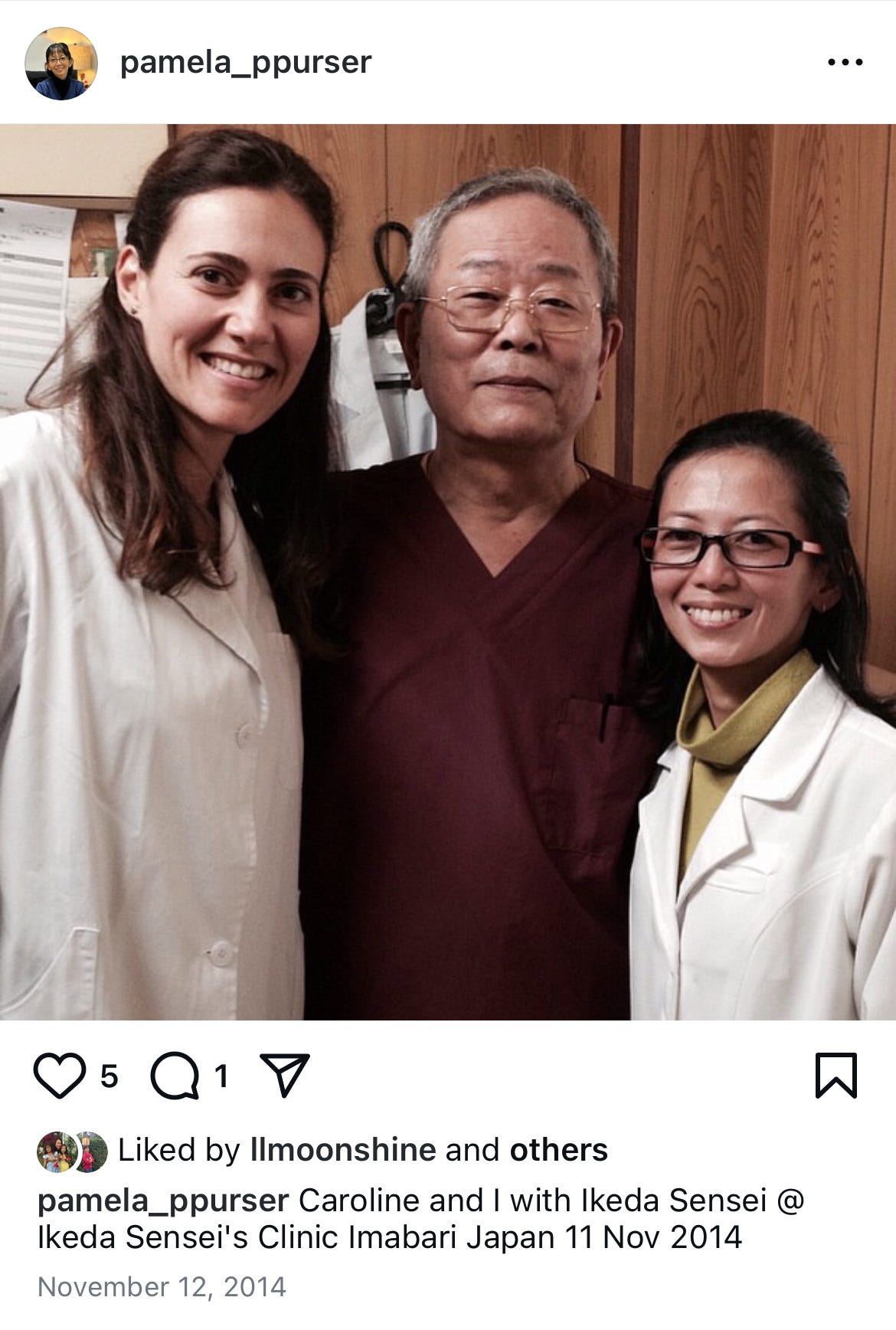Sometimes, the journey itself becomes the lesson. And sometimes, it’s the courage to take the journey that shapes you more than the destination - Pamela Purser.In 2013, my husband and I were living in Japan—a time filled with exploration and self-discovery. My acupuncture license didn’t carry over to this new country, so I couldn’t practice. But instead of stepping away from my calling, I chose to step closer to its roots.
I decided to find and study with one of the most respected names in Japanese acupuncture: Ikeda Masakazu, a preeminent teacher and practitioner in Traditional Japanese Acupuncture and Moxibustion. His name was in textbooks, his wisdom legendary. And now, he was real, living in a remote corner of Imabari Island.
Japanese acupuncture is unique. Unlike the more commonly known Chinese styles, it emphasizes subtlety and precision, using finer needles, lighter insertions, and an almost meditative approach to diagnosis and treatment.
Moxibustion, the art of using burning moxa to stimulate healing points, is seamlessly integrated, embodying the duality of fire and calm. I wanted to immerse myself in this tradition, to touch the roots of a lineage that prized both technique and heart.
But finding him wasn’t easy.
It took weeks of planning—memorizing kanji, mapping bullet train schedules, coordinating local trains and taxis. My Japanese was basic at best, and the master spoke little English. Thankfully, his apprentice, fluent enough, became my bridge.
The journey itself was a test. Four hours. Multiple transfers. And an unwavering resolve to meet the man whose work I admired from afar.
When I finally arrived, I stepped into his modest clinic, heart pounding. The room was minimalist, uncluttered—no fancy machines, no distractions. Just the essentials: clean tatami mats, acupuncture tools, and a quiet air of reverence. I didn’t know what to expect.
But here’s what I learned that day:
1. Wisdom Isn’t Taught. It’s Absorbed.
The day was packed with active observation. I listened to translated snippets, watched Ikeda Sensei’s precise movements, and soaked up the energy in the room. He didn’t lecture me. Instead, he showed me how he embodied his craft.
There was a flow to his actions, a quiet confidence that came not from effort, but from a deep understanding. Watching him diagnose and treat patients, I saw how his movements mirrored the balance he sought to restore in others. Each needle was placed with the deliberation of an artist.
It wasn’t about memorizing protocols; it was about feeling the moment. His presence alone was the lesson. Each action spoke volumes about harmony, balance, and intention—core principles of acupuncture and, I realized, life itself.
2. The Most Profound Lessons Are Simple.
I came seeking skills, techniques, and formulas. What I left with was far more valuable: his guiding principle.
He told me, “Always treat from the heart. The skills will follow.”
In that moment, I understood. Techniques may be learned, but true healing requires sincerity and compassion—a willingness to connect with something deeper.
This philosophy is a cornerstone of Japanese acupuncture. Practitioners focus on sensing their patient’s Qi—an intangible life force—before choosing techniques. It’s about partnership, not prescription. By treating from the heart, a practitioner aligns themselves with the natural flow of life, making healing a shared journey.
3. Humility is the Gateway to Growth.
I wasn’t there to prove myself. I was there to learn, and in my novice state, the only thing I could bring was gratitude. That openness unlocked a kind of learning I didn’t realize I needed.
Humility is often seen as a passive trait, but I learned it’s an active practice—a conscious decision to acknowledge what you don’t know and to remain curious.
Watching Ikeda Sensei work reminded me that mastery isn’t about accumulating knowledge; it’s about refining your spirit. It’s about shedding ego and embracing the role of a lifelong student.
4. The Power of Persistence and Courage
The effort it took to reach Imabari wasn’t just logistical. It was deeply emotional. Each step challenged my resolve, my comfort zone, and my confidence.
But courage and persistence are vital not just in travel but in healing and life. Healing, whether physical or emotional, requires showing up for yourself, even when the path is unclear. It’s about trusting the process and being willing to face discomfort.
Ikeda Sensei’s practice reflected this beautifully. His patients came from all over, often seeking solutions they couldn’t find elsewhere. And his quiet persistence, rooted in the traditions of Japanese acupuncture, gave them hope.
5. The Japanese Concept of Shokunin:
One of the most profound lessons I connected to during my time in Imabari was the Japanese concept of Shokunin.
Shokunin translates loosely to “artisan” or “craftsperson,” but it means much more. It embodies the spirit of dedication, mastery, and humility in one’s work. A Shokunin doesn’t strive for perfection to show off but to honor their craft, their community, and the greater good.
Watching Ikeda Sensei work, I realized he was the embodiment of Shokunin. Every movement, every decision was deliberate, done with care and respect. He wasn’t working just to heal; he was creating harmony, one needle at a time.
This idea of Shokunin has stayed with me. It reminds me to approach my own craft—not just acupuncture, but life itself—with the same spirit of dedication and humility.
6. The Unseen Energy of Space and Ritual
Another lesson I took away was the importance of space and ritual in healing. The atmosphere of the clinic wasn’t an accident. Every detail, from the clean lines of the decor to the unhurried pace of the treatments, contributed to the healing experience.
It reminded me of the importance of creating intentional spaces in our lives—places where we can reconnect with ourselves and find balance. Whether it’s a meditation corner at home or a deliberate morning ritual, these spaces hold the power to restore us.
A Quiet Transformation
Leaving that day, I didn’t feel like I’d mastered anything new. But I did feel profoundly changed. And isn’t that the real goal of any journey?
The experience wasn’t about becoming a master overnight. It was about courage, persistence, and opening myself to wisdom greater than my own.
Sometimes, the best souvenirs aren’t physical—they’re the shifts in your perspective, the quiet truths that stay with you long after you leave.Your Turn
What’s one journey you’ve been putting off? One master you’ve been too afraid to approach?
Trust me—if you take the first step, the heart will guide you.
So, here’s my takeaway for you:
Healing, growth, and transformation all begin with a willingness to explore. Whether it’s through travel, a new practice, or simply taking time to connect with yourself, the journey is worth it.Got eight minutes? Let’s take the next step together.





